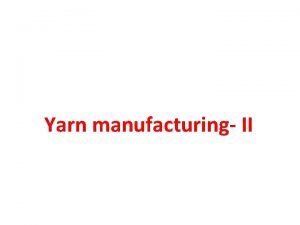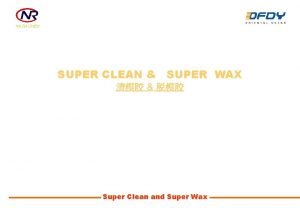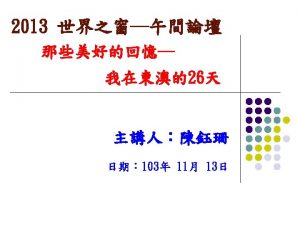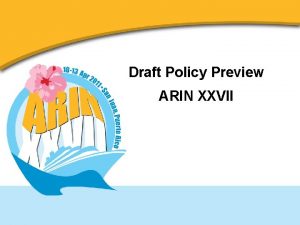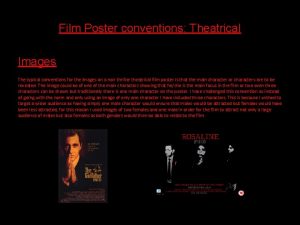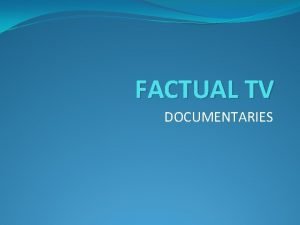SurfaceVolume Conventions and the Draft Super Regulation Mark




















- Slides: 20

Surface/Volume Conventions and the Draft Super Regulation Mark Vints Amcor Flexibles / Flexible Packaging Europe 12 April 2005 1

draft Super Regulation EMB/993 -Rev. 6 -3 Article 11 – Specific restrictions of substances – Option A 2. The SMLs … are expressed in mg (of substance) / kg (of food or food simulant). However such limits are expressed in mg/dm² (of surface area of material or article in food contact) in the following cases: a) containers and other articles which can be filled; with a capacity of less than 100 ml or 100 grams or more than 10 l; b) containers and other articles sheet, film and other articles which cannot be filled or for which it is impossible to estimate the relationship between the surface area of such material or articles and the quantity of food in contact therewith. 3. In the cases described under (a) and (b), the limits … expressed in mg/kg shall be divided by the conventional conversion factor of 6 in order to express them in mg/dm². 2

draft Super Regulation EMB/993 -Rev. 6 -3 Article 11 – Specific restrictions of substances – Option B 2. The SMLs … are expressed in mg (of substance) / kg (of food or food simulant). However such limits are expressed in mg (of substance) / dm² (of surface area of material or article in food contact) in the following cases: a) containers and other articles which can be filled or, even if they cannot be filled, for which it is possible to calculate the S/V (surface area of material or article / volume of food in contact), having a capacity of less than 100 ml or 100 grams or more than 10 l; b) containers and other articles sheet, film and other articles which cannot be filled or for which it is impossible to estimate the relationship between the surface area of such material or articles and the quantity of food in contact therewith. 3. In the cases described under Paragraph 2 (a) and (b), the migration, measured or expressed in mg/dm², shall be multiplied with the factors mentioned in the table below before verifying compliance with the relevant SML (“conversion factors”). 3

draft Super Regulation EMB/993 -Rev. 6 -3 Article 11 – Specific restrictions of substances – Option B Category of material or article Type of food in contact with material or article or: [Type of material or article in contact with food] Conversion factor Cat. A For materials which envelop small portions of food entirely or in large part (e. g. light weight foods or single portion person packages) or for which the ratio S/V is higher than 12 12 Cat. B For materials which envelop the food or beverage entirely or in large part (e. g. prepared foods and beverages) 6 Cat. C For materials a relatively small surface of which comes into contact with foods and beverages (typically parts of food production machinery) 0. 5 Cat. D For food utensils, (including containers), having a capacity of more than 10 litres but less than 10 000 litres Cat. E For containers/tanks having a capacity of more than 10 000 litres 0. 2 Cat. F For tubes and hoses normally used for continuously conveying a flow of liquid(s) 0. 1 3 4

draft Super Regulation EMB/993 -Rev. 6 -3 Article 12 – Overall migration limit – Option A 1. Plastic materials and articles shall not transfer their constituents to foods or the food simulants … in quantities exceeding 60 milligrams (of the total constituents released) / kilogram (of food or food simulant). 2. This limit shall be 10 milligrams per square decimetre of surface area of material or article in the following cases: a) articles which are containers or are comparable to containers or which can be filled; with a capacity less than 100 ml or 100 grams or more than 10 l; b) sheet, film and other articles which cannot be filled or for which it is impracticable [impossible][impracticable][Eu. PC] to estimate the relationship between the surface area of such materials or article and the quantity of food in contact. 5

draft Super Regulation EMB/993 -Rev. 6 -3 Summary of proposals: 1. SML option B: changes the conventional S/V ratio in certain cases from 6 dm²/kg to a higher (12) or lower value (down to 0. 1) depending on the application (see table). 2. SML and OML: changes the range of packaging sizes for which the real S/V applies in compliance assessment, from a current range of 10 l to 500 ml to a proposed range of 10 l to 100 ml. 6

what are our problems with these proposals? 1. Objections on the principle S/V is just one parameter in the conventional exposure scenario: 60 kg consumer / 1 kg of food per day / 75 years / 6 dm² / migration = SML Reworded conventional exposure scenario: consumer is exposed to 6 dm² of plastic per day in which every listed substance is present and migrating at its SML. What does this mean? If all substances with SML would be present in every material, and would all migrate at their SML, their combined migration from 6 dm² would exceed the OML by a factor 100 or more, while in reality it is typically 1/10 th the OML or less. Ø the conventional exposure scenario overestimates exposure by at least a factor 1000. 7

what are our problems with these proposals? Given the high overestimation of exposure and the additional safety factors, it is not justified to make adjustments which would increase the magnitude of the overestimation. Consumer protection is more than sufficient even if: • the real S/V of packaging is often >6 dm²/kg • food consumption is ~3 kg/day when including beverages • infants consume 1 kg per 20 kg b. w. (which is same consumption as 3 kg for 60 kg adult) Solving ‘problems’ with individual substances or materials by adjusting the general system, is not appropriate. Ø any of the above points of concern can only be correctly addressed by more refined exposure assessments. 8

what are our problems with these proposals? 2. Editorial problems Without wanting to spend time discussing these: • package capacity in ml weight of food in g. • how much time & effort lies between ‘possible’ and ‘practical’ when determining the S/V? • which category applies from the table of conversion factors? Ø what is a small portion of food? Ø lidding films or caps are a minor part of the ‘envelop’, yet most of their surface contacts the food; Ø plastic coffee stirrer seems to fit nowhere. 9

what are our problems with these proposals? 3. Compliance assessment problems In the current system, virtually all compliance assessments refer to the conventional S/V of 6 dm²/kg: • semi-finished materials or articles • finished materials or articles which cannot be filled • finished materials or articles which can be filled, S/V unknown • finished materials or articles which can be filled, < 500 ml • finished materials or articles which can be filled, 500 ml - 10 l, if S/V is assumed to be ~ 6 dm²/kg 10

what are our problems with these proposals? changes under the draft Super Regulation: • Art. 11 Option B: SML / 2 below 100 ml SML / 2 above 100 ml • Art. 11 Option A: SML / (1/6 th S/V) above 100 ml • Art. 12: OML / (1/6 th S/V) above 100 ml The impact of the 2 nd and 3 rd case here above depends on the value of the real S/V of the finished food packaging. Independent data on S/V: “Domestic use of food packaging materials in the Netherlands” by Krista Bouma et al. (Aug. 2003) – next slide. 11

the real S/V of food packaging materials 12

the real S/V of food packaging materials Conclusion on the previous dataset: no discussion: often S/V > 6 dm² per kg of food packed. the real question to ask: what is S/V per kg of food consumed? Ø this question requires “exposure”! Looking more closely between 100 and 500 g where changes apply: • from 500 to 100 g, the average S/V increases from 14 to 34. • between 500 and 100 g, the statistical average of the datapoints is 23 dm²/kg (for average package size of 245 g) but ranges from 4 to 140. Ø OML and SML typically change by a factor 2 to 6, with extremes up to a factor 23. 13

some Questions & Answers Q: Can packaging comply when OML and SML become stricter? A: Difficult or not; the factor is too high (5, 10, 20? ) and the scope of materials affected too wide. Q: Can the materials not simply be reformulated to comply? A: Appropriate materials meeting the stricter limits are simply not existing for many applications. Q: What will happen if the proposed changes go through anyway? A: Many materials will disappear from the market or will not comply. Many packaging applications will be lost. 14

illustration in the case of OML Practical problems that arise: • difference between OM and OML determines testing frequency; lower OML increases cost and effort of compliance. • packaging applications with high OM (~ processing conditions) could fail to find compliant packaging tomorrow. • analytical uncertainties of 2 mg/dm² (ABC) or 3 mg/dm² (D) apply; a result equal to these values is ‘non-detectable’. Ø at S/V = 30 (ABC) or 20 (D) compliance with OML becomes a ‘non-detectable’ requirement. Ø at S/V higher than 30 (ABC) or 20 (D) the OML test is not valid (result is required to be lower than detectable). 15

illustration in the case of OML Krista Bouma data: assume OM = 2 mg/dm² for all datapoints. 16

illustration in the case of OML Actual test results of Overall Migration for cases where the real S/V is known 17

conclusion on OML many packages between 500 and 100 ml, and the majority of those near 100 ml, cannot comply with the OML based on the real S/V. Only refined exposure estimates can clarify whether or not this results in any ill effect on consumer health & safety. With initiatives on exposure currently underway, this clarification is just a matter of some time. 18

the case of SML compliance has many different SML values and refers to multiple methods each with its own detection limit, so cannot easily be shown in a graph similar to the OML case. Nevertheless the following facts are clear: • petitions for substances generally submit tox data sufficient to justify the experimental migration values. This minimizes the difference between the experimental migration and the SML. • the migration data used in petitions universally applies the conventional S/V of 6 dm²/kg. Ø high probability that some substances will fail their SML if a correction factor to the real S/V applies. 19

Overall Conclusions Changing the conventional S/V or the volume range in which it applies • increases the overestimation of consumer exposure • causes materials to fail the OML, notably close to 100 ml • causes substances to fail the SML if migration >~1/10 th SML • causes certain materials and/or applications to disappear from the market or become illegal • disrupts a supply chain which is the most regulated in the world and has a proven track record of safety & consumer protection Ø pending availability of a refined exposure assessment, S/V = 6 dm²/kg should apply universally. 20
 Relation between actual draft and mechanical draft
Relation between actual draft and mechanical draft Super worm is super long
Super worm is super long Reviewing and correcting the final draft of a message is
Reviewing and correcting the final draft of a message is Hình ảnh bộ gõ cơ thể búng tay
Hình ảnh bộ gõ cơ thể búng tay Lp html
Lp html Bổ thể
Bổ thể Tỉ lệ cơ thể trẻ em
Tỉ lệ cơ thể trẻ em Voi kéo gỗ như thế nào
Voi kéo gỗ như thế nào Tư thế worm breton
Tư thế worm breton Hát lên người ơi alleluia
Hát lên người ơi alleluia Kể tên các môn thể thao
Kể tên các môn thể thao Thế nào là hệ số cao nhất
Thế nào là hệ số cao nhất Các châu lục và đại dương trên thế giới
Các châu lục và đại dương trên thế giới Công của trọng lực
Công của trọng lực Trời xanh đây là của chúng ta thể thơ
Trời xanh đây là của chúng ta thể thơ Mật thư anh em như thể tay chân
Mật thư anh em như thể tay chân Làm thế nào để 102-1=99
Làm thế nào để 102-1=99 Phản ứng thế ankan
Phản ứng thế ankan Các châu lục và đại dương trên thế giới
Các châu lục và đại dương trên thế giới Thể thơ truyền thống
Thể thơ truyền thống Quá trình desamine hóa có thể tạo ra
Quá trình desamine hóa có thể tạo ra
